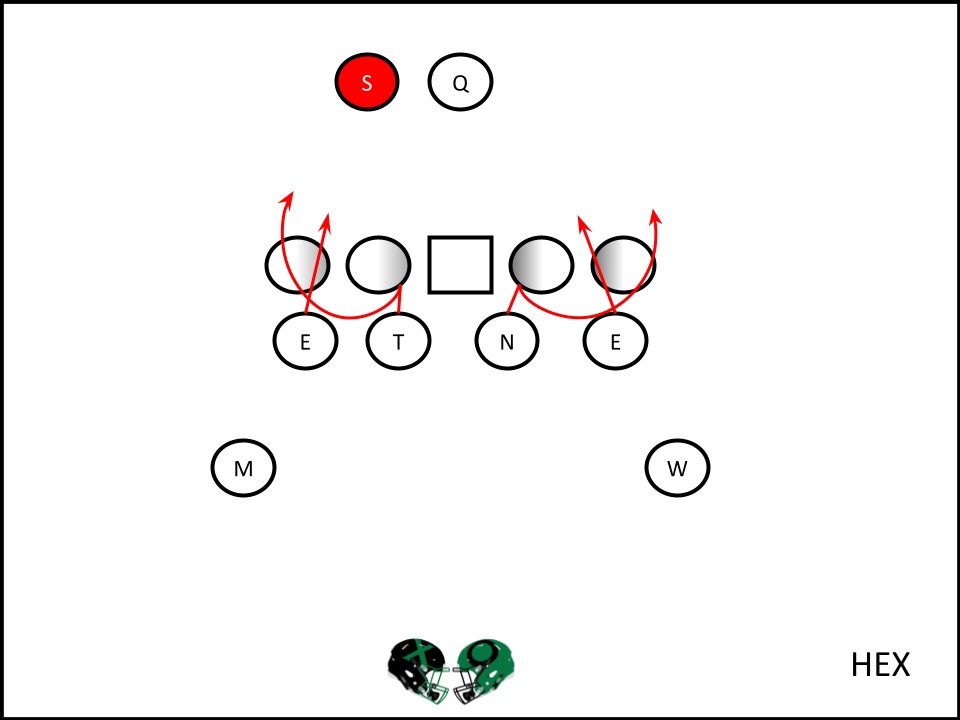"Hex" Front Theory: Can 4-Down Defenses Steal from Tite?
An exercise in defensive theory
For years, my coaching circle has kicked around this oddball front, something we sketched on napkins, but never had a name for. We always wondered: could this look screw with an offense enough to be worth installing? I’m sure someone out there is already running it and calling it something slick. But since we haven’t seen it labeled, we’re calling it the “Hex” front.
What is the Hex front? And why run it?
The Hex Front sets the defensive line in two 4i’s and two 2i’s, with the linebackers walked up in 50s. Think of it like a four-down version of Tite, only now you’ve got a linebacker already in the interior fit pre-snap. By alignment alone, you’re choking off the interior gaps and forcing the ball to spill. Why run it? Same reasons an odd front team lives in Tite: it muddies up the double teams and wrecks zone combos. Especially against spread teams trying to work inside and outside zone, this look can jam up their rules before the ball is even snapped.
Has anyone used this front?
We haven’t seen this exact front show up on film, but we’ve caught glimpses, teams stunting into it or lining up in something close. Notre Dame, for example, used a similar look against Navy’s option game. It did a great job of disrupting Veer and Midline, took away the angles, and forced the ball into bad decisions.
Ohio State, out of their 4-down, 3-high structure, has stunted into something that echoes the Hex. In the clip below, they line up in a similar look, no true backers in the box. The D-line works to the interior gaps, leaving the edges for the linebackers to clean up anything that bounces. On this snap, the defensive tackle comes free inside and finishes with a TFL. Textbook fit from a non-traditional front.
Here’s how you could fit Counter from that same Hex look. Both linebackers are still outside the box, with the “middle safety” sitting at 7–8 yards deep. The D-line’s job is to spill everything wide. That forces the ball to the middle safety scraping over the top, right into the teeth of the fit.
“This would be a great front to stem to and not allow the offense to check into a good beater for it” -Clayton Cason | DC | Mandarin High School
Weaknesses to the front
Like any front, Hex comes with its tradeoffs. Just like Tite, it’s vulnerable to schemes like Pin & Pull or Dart, anything that can outflank the edges quickly. Pass rush can also be a challenge out of 2i’s and 4i’s. That’s where “Cop Rush” mechanics or natural twists come into play. As shown in the diagram below, once the D-line reads pass, they transition into late-game twists to generate pressure.
Conclusion
At the end of the day, this is just a thought experiment, an attempt to build a Tite-like structure out of a four-down look. What makes it compelling is the simplicity: you’re creating a built-in gap exchange pre-snap. It could be a useful wrinkle, especially against 10 and 20 personnel spread teams. That said, it’s probably not something you can live in like a traditional Tite front. And yeah, the same old issues show up,Pin & Pull, Dart, and the other usual suspects. Still, we’re curious: could this thing hold up? Or is it better left as a stunt rather than a static front? Let us know what you think!
Bonus
Board Drill subscriber Evan Hartman shared a clip of Northwest Missouri State breaking down how they implement a similar front in their defensive system.







I've considered for the last 3 years and haven't committed
It exists (kind of):
https://youtu.be/R-FcvX9ttdk
You could talk to coaches from Wartburg College, Grand Valley State, or Ferris State. They all run versions of it.
If you want a guest, reach out to Coach Matt Webb at Maryville in Missouri.
We tried running it last year, and its tough for a number of reasons. It does work if you can pull it off.
Might look at Iowa and how they use the DL to eliminate open interior gaps with checked stunts and 2 gap play (like your recent guest) when they displace lbs to stay +1 on the outside and have a light box.
The innovation I see is doing it from 3 high 4-2 structure and using 2 ILBs to fit the c gaps with a middle safety playing the interior instead of using a 4-3 structure and having 2 OLBs fit the c gaps with a Mike playing the interior. Very similar ideas, executed differently.